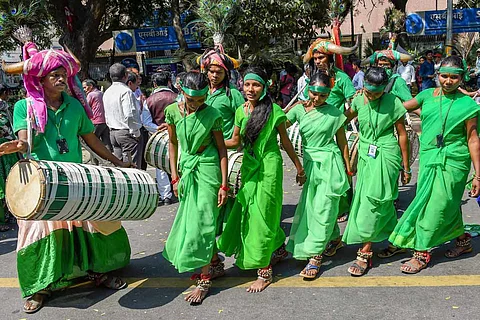

Gunmantharao belongs to the Koya tribe from Mussalamma thanda in Telangana’s Mulugu district. But despite belonging to the tribe, neither he nor his parents could speak the Koya language, as they relocated to outside the thanda. Three years ago, however, when Gunamntharao began working as a voluntary educator in the same district for Koya tribal children, he realised the need to preserve the language, which is on the verge of extinction. “Small children who were from the tribe did not know any language apart from the Koya. They were unable to express their needs even in emergency situations like at hospitals. Then, with the help of the children I learned the language gradually and started teaching the students in a way that they would understand, and started mediating with authorities for their needs,” he said
With the number of people knowing tribal languages in Telangana reducing, the communities have also been struggling to communicate their needs to the rest of the state efficiently. Telangana has about 13 recognised tribal communities with a significant population, which are spread over the regions of Adilabad, Achampet, Mulugu, Warangal and Mahbubabad, among others. Some of the languages that these tribes speak, including Gondi, Koya, Kolami, Kondh and Banjara, are slowly losing their ground, as the number of people who speak these languages have been dwindling. Of these, Gondi has already been listed as an endangered language in the UNESCO list, according to the state Ministry of Tribal Affairs.
When people from the tribal communities move to cities, their languages start to lose prominence as they cannot speak it with others outside their community. There is also a sense of shame associated with speaking tribal languages in cities, Kunal Rathod, vice president of Tribal Reservation Porata Samithi said. “In cities like Hyderabad, tribal languages are fast disappearing. Despite the fact that we speak in the language at home, our children feel ashamed to speak the same outside the community and they say they are comfortable with either Telugu or Hindi. This should not be the case. People speaking their native language should not be humiliated or looked down upon,” he explained.
Dr Surya Dhananjay, a Telugu professor and Director of the Centre for Women Studies in Osmania University, who wrote a book on Gor Banjara, an Enduring Tribe, says that the disappearance of the language poses the risk of the disappearance of the community itself. “If there are no people speaking a language, it also means we are losing that community, culture and identification altogether. Imagine, if there are no people who can speak Telugu, how will the community identify itself and preserve its culture for future generations? The same goes with the tribal languages as well— with the language, there is wisdom, knowledge, literature from these communities that we are losing,” she pointed out.
With tribal languages facing the risk of extinction, state government officials said that measures are being undertaken to help preserve them. Since 2018, they have been issuing textbooks in four tribal languages — Gondi, Kolami, Koya, Banjara — for children, who are usually taught in Telugu-medium schools.
Speaking to TNM, Joint Director of the Tribal Cultural Research & Training Institute, V Samujwala said, “In order to decrease the dropout rate among the tribal students, we have come up with textbooks in their native languages, for better understanding. As these languages do not have any script, we have used pictures of daily activities and objects, and have given the associated words in the tribal languages as well as Telugu.”
However, Gunmantha Rao said that in the last three years that he has been helping the Koya tribal children with their education, he did not see these textbooks distributed or given to the students. According to the Tribal Welfare Department, the COVID-19-induced lockdown obstructed the process of distribution. “There were also plans to estimate the dropout rate, before and after the distribution of the books, but with the COVID-19, works have been halted, as it was all online education,” V Samujwala said.
Cover page of Koya Vachakam book
Inside page from Kolami Vachakam text book
There are about 1,400 tribal schools in the state and it was mandated that there should be a Mother Tongue Based Multilingual Education (MTBME) programme for the tribal children of classes 1 and 2 in their native language, as per the Right to Education, 2009 as well as the New Education Policy of 2020. However, the same is yet to be implemented in the schools.
According to Dr Surya Dhananjay, there is a need for more research into the tribal languages and culture in order to preserve it for future generations. The professor, who is from the Banjara community herself, completed her post doctoral degree on the oral traditions of the tribe. She is also working on a Banjara dictionary, which is yet to be published.
Osmania University also offers a paper on ‘Girijana Vignanam’, which covers the tribal communities in Telangana and introduces students to tribal cultures and traditions. This paper was introduced in the varsity a few years after the formation of Telangana.
Syllabus of Girijana Vignanam paper
Meanwhile, the Tribal Welfare Department is also planning to introduce a digital database of the tribal languages, which includes literature in audio form. “There are several songs, poems and other important things that are part of their community. All these, we are planning to have an audio base for the future generations. This has been proposed and yet to be implemented," Samujwala said.